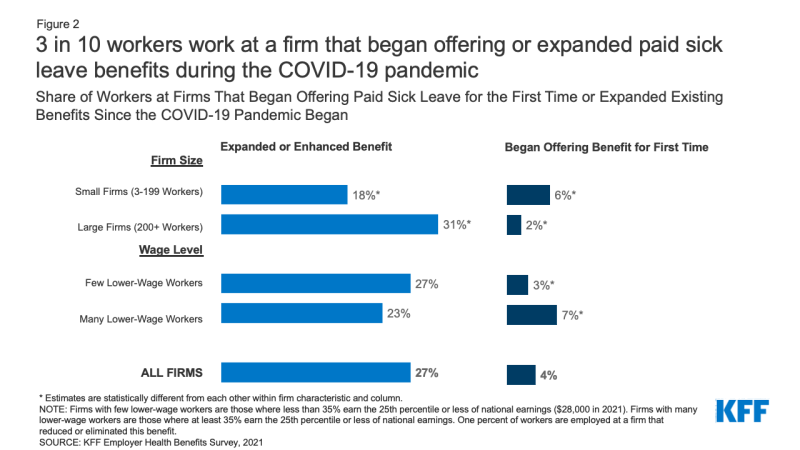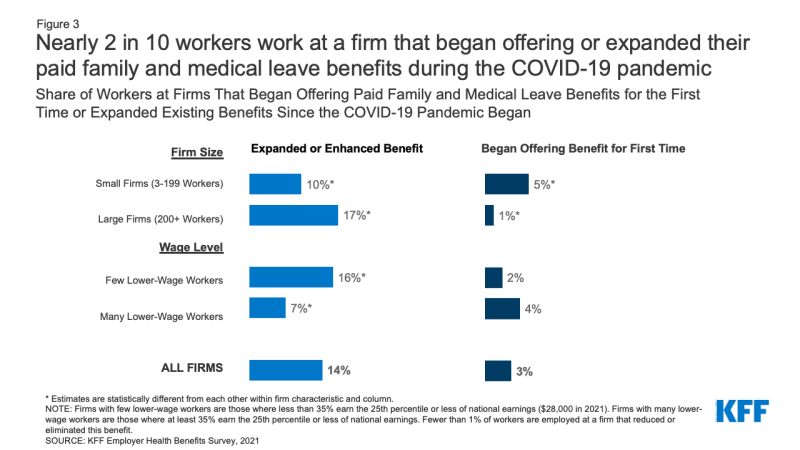Employers Strengthen Paid Leave Benefits During the COVID-19 Pandemic: Findings from the 2021 KFF Employer Health Benefits Survey
Benefits such as sick leave and paid family and medical leave can help workers meet their personal and family health care needs with greater financial security. This issue has gained new urgency during the COVID-19 pandemic as workers needed time off work to recover from the virus and to care for children and other family members who had fallen ill.
Unlike all other wealthy countries, the U.S. does not have a national paid leave mandate. The federal Family and Medical Leave Act (FMLA) requires some employers to provide job-protected, unpaid time off to eligible employees for family caregiving and medical leave, but just over half (56%) of the workforce is eligible. According to the Bureau of Labor Statistics (BLS), eight in ten workers (79%) have access to paid sick leave through their employer and less than one in four (23%) workers have access to paid family leave. Data on the share of workers with access to paid medical leave for a longer, serious illness are limited, although BLS also estimates that 40% of workers have access to short-term disability insurance.
As a result of the COVID-19 pandemic, some employers announced changes to their paid leave policies to ensure more workers have access to paid leave and to reduce the risk of workers coming to work sick. This data note presents findings from the 2021 KFF Employer Health Benefits Survey1 on the share of workers who are employed by firms that began offering or expanded their paid leave benefits since the COVID-19 pandemic began.2
Paid Sick Leave: Paid sick leave can be used to recover from a short-term injury or illness such as a cold or for doctor’s appointments. It is often provided on an accrual basis up to a set number of hours or days per year, such as one hour of leave earned for every 30 hours worked up to seven days per year, and replaces 100% of the worker’s regular wages. The average duration of paid sick leave private sector workers are provided is seven days per year. Paid sick leave benefits are paid by the employer.
Paid Family and Medical Leave: Paid family and medical leave typically provides a set number of weeks or months to be used for a worker’s own serious, longer-term health condition, to care for a family member with a serious health condition or to care for or bond with a new child, and for reasons related to a family’s member’s military service. On average, it provides six to twelve weeks of fully or partially paid leave per year, without the need for accrual. Paid family and medical leave may be insured and is often funded by payroll contributions from the employer and/or the worker.
Findings
In total, nearly four in ten workers are employed at a firm that began offering paid leave during the pandemic or expanded their existing paid leave benefits.
Thirty-seven percent (37%) of workers work at a firm that began offering paid sick leave or paid family and medical leave for the first time or expanded or enhanced those benefits since the COVID-19 pandemic began (Figure 1). This includes 31% of workers at firms that began offering or expanded paid sick leave and 17% of workers at firms that began offering or expanded paid family and medical leave. One percent (1%) of workers are employed at a firm that reduced or eliminated either of their paid leave benefits.
Looking at these changes separately, 4% of workers work at a firm that began offering paid sick leave for the first time since the COVID-19 pandemic began and 27% of workers work at a firm that expanded or enhanced their existing paid sick leave benefit. One percent (1%) of workers are employed at a firm that either reduced or eliminated their paid sick leave benefit.
Three percent (3%) of workers work at a firm that began offering paid family and medical leave for the first time since the COVID-19 pandemic began and 14% work at a firm that expanded or enhanced their existing paid family and medical leave benefit. Fewer than 1% of workers are employed at a firm that either reduced or eliminated their paid family and medical leave benefit.
These shares vary based on firm characteristics. For paid sick leave, workers at small firms (3-199 workers) are more likely than workers at large firms (200 or more workers) to work at a firm that began offering paid sick leave for the first time (6% vs. 2%) (Figure 2). Workers at large firms are more likely to be at a firm that expanded upon their existing paid sick leave benefits (31% vs. 18%). Similarly, workers at firms with few lower-wage workers3 are more likely to work at a firm that began offering paid sick leave for the first time than workers at firms with many lower-wage workers (3% vs. 7%).

Figure 2: 3 in 10 workers work at a firm that began offering or expanded paid sick leave benefits during the COVID-19 pandemic
There is also variation by firm characteristics for paid family and medical leave. For example, workers at small firms are more likely than workers at large firms to work at a firm that began offering paid family and medical leave for the first time (5% vs. 1%) (Figure 3). Workers at large firms are also more likely to be at a firm that expanded upon their existing paid family and medical leave benefits (17% vs. 10%). Similarly, workers at firms with few lower-wage workers are more likely to work at a firm that expanded or enhanced their paid family and medical leave benefits than workers at firms with many lower-wage workers (16% vs. 7%).

Figure 3: Nearly 2 in 10 workers work at a firm that began offering or expanded their paid family and medical leave benefits during the COVID-19 pandemic
In general, workers at small firms are more likely to be employed by a firm that began offering paid leave benefits during the pandemic and those at larger firms are more likely to work at a firm that expanded upon their existing paid leave benefits. These findings reflect prior research indicating that paid leave benefits were already more common among larger firms and less common among smaller firms.
Discussion
The COVID-19 pandemic added new urgency to the importance of paid leave. In 2020, the Families First Coronavirus Response Act (FFCRA) temporarily required employers with fewer than 500 workers and all public employers to provide up to two weeks of fully-paid sick leave to workers unable to work due to their own quarantine or symptoms of coronavirus and up to two weeks of partially paid leave to workers who needed time off work to care for someone in quarantine. Those mandatory benefits expired at the end of 2020. (Note that our survey asked changes firms made to regular paid leave benefits; not the temporary FFCRA paid leave benefits.)
Paid leave continues to garner national attention among both the public and policymakers. The 117th Congress continues to debate including a universal paid family and medical leave program as part of the Build Back Better Act. House Democrats initially proposed 12 weeks of paid leave annually for all workers in the U.S. that may be taken to recover from a serious illness, care for a seriously ill family member, and welcome a new child. The proposal currently being debated was reduced to four weeks of paid leave. Whether this proposal becomes enacted remains uncertain. Without congressional action, the availability and generosity of paid leave will continue to depend on decisions made by employers and by state and local policymakers.
While many employers have responded to the need for paid leave during the pandemic, it is unclear whether they will ultimately sustain, continue to strengthen, or scale back these new or enhanced benefits after the pandemic subsides.
Methodology
The annual KFF Employer Health Benefits Survey (EHBS) for 2021 was conducted between January and July of 2021, and included almost 1,700 randomly selected, non-federal public and private firms with three or more employees. The full EHBS, including a detailed methodology section, is available at ehbs.kff.org.
We asked respondents about changes4 to their paid leave benefits they made during the COVID-19 pandemic, beginning in January 2020, that were in effect at the time of the interview. Paid leave programs included a firm’s regular paid sick leave and paid family and medical leave programs, not those made temporarily available during the pandemic. Family medical leave only included paid leave benefits and not an employer’s unpaid leave obligations under FMLA. This survey is unable to separate the robustness of paid leave benefits including whether a firm offered benefits prior to the pandemic or whether changes made to paid leave benefits were already planned prior to the start of the pandemic.
Endnotes
The 2021 KFF Employer Health Benefits Survey report will be published on November 10, 2021, at ehbs.kff.org.
Our survey asked firms about changes they made to regular paid leave benefits; not the temporary, federal COVID-19 emergency paid leave program that expired at the end of 2020.
Firms with few lower-wage workers are those where at least 35% earn the 25th percentile or less of national earnings ($28,000 in 2021). Firms with many higher-wage workers are those where at least 35% earn the 75th percentile or more of national earnings ($66,000 in 2021).
Question wording: Since the COVID-19 pandemic began, has your firm changed its [paid sick leave benefit] [paid family and medical leave] by offering the benefit for the first time, expanding or enhancing this benefit, keeping this benefit the same, reducing this benefit, not applicable/firm doesn’t offer any workers [paid sick leave benefit] [paid family and medical leave], or don’t know.
